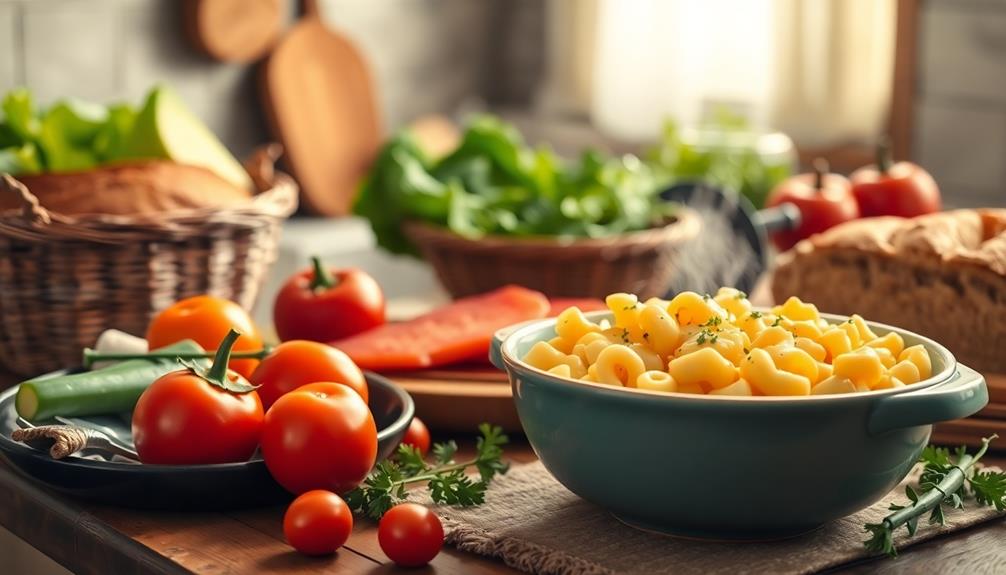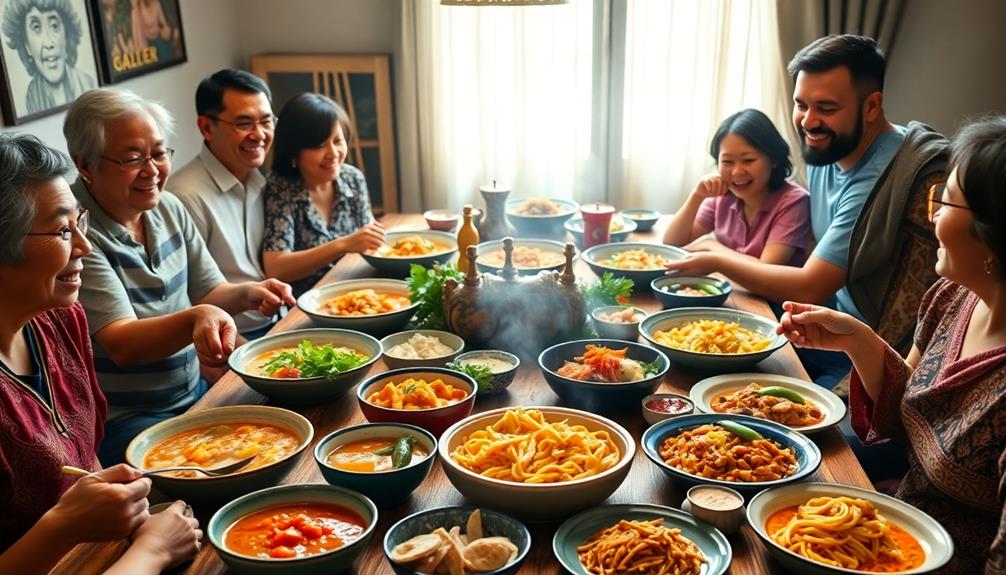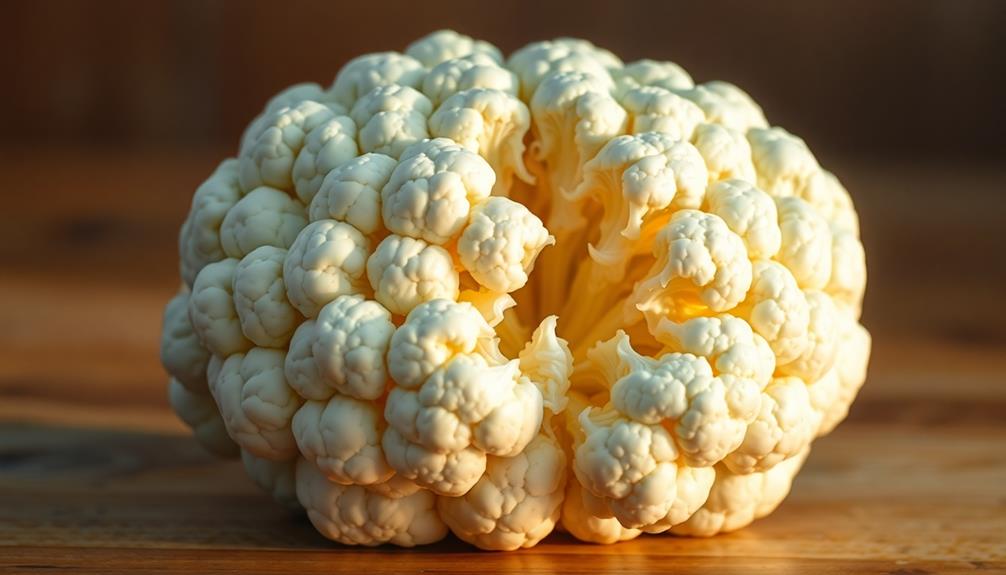You associate comfort food with warm memories and emotional reassurance, revealing how your brain processes these connections. When you indulge in high-fat or high-sugar foods, your brain releases neurotransmitters like dopamine, creating feelings of pleasure and happiness. These foods often evoke nostalgia, tied to childhood experiences or family gatherings. While they provide short-term comfort, they can lead to long-term health risks. Different cultures also influence your comfort food preferences, showcasing how traditions shape your emotional relationships with food. Explore further, and you might uncover more surprising insights about these tasty connections and their effects on your well-being.
Key Takeaways
- Comfort foods activate brain reward pathways, releasing dopamine and serotonin, enhancing mood and pleasure during emotional distress.
- High-fat and high-sugar foods elicit stronger pleasure responses, particularly in sensitive individuals, reinforcing cravings during stress or loneliness.
- Childhood experiences and family gatherings create psychological associations with specific comfort foods, linking them to feelings of security and happiness.
- Emotional satisfaction from comfort foods often outweighs nutritional benefits, leading to potential long-term health risks if consumed excessively.
- Modern trends showcase gourmet adaptations of comfort foods, merging nostalgia with health-conscious choices while still stimulating brain reward responses.
Understanding Comfort Food

Many people find comfort food to be a source of solace during tough times. You likely have specific dishes that evoke memories of childhood or family gatherings, filling you with warmth and happiness. This emotional connection is no accident; comfort food often triggers the release of neurotransmitters like dopamine and serotonin, which enhance your mood and provide temporary emotional relief.
Dishes like Yeduba Wat or a warm bowl of Chao can exemplify this connection, as they're deeply rooted in cultural traditions and often enjoyed during significant moments in life.
When you indulge in high-calorie, high-fat, or high-carbohydrate foods, you're not just satisfying a craving; you're activating your brain's reward pathways. These pathways respond similarly to certain drugs, making you feel rewarded and soothed. It's no wonder you might find yourself reaching for that familiar dish when life gets overwhelming.
The memories tied to specific comfort foods elicit strong emotional responses, reinforcing feelings of security and happiness. Plus, cultural influences play a role in shaping your comfort food preferences, reflecting local traditions and ingredients.
Whether it's mac and cheese, a warm bowl of soup, or a favorite dessert, each bite can bring a sense of emotional well-being, reminding you of the good times and providing the comfort you seek.
Brain Chemistry and Emotions

There's a fascinating interplay between brain chemistry and the emotions we experience, especially when it comes to comfort food. When you indulge in your favorite comfort foods, your brain releases neurotransmitters like dopamine and serotonin, boosting your mood and creating a sense of pleasure.
This is particularly true when high-fat and high-sugar options come into play, as they activate the nucleus accumbens, a key area in your brain's reward pathways. Foods like Mushroom Masala or sweet treats such as Rasgulla can evoke strong positive associations, further enhancing the comfort food experience.
If you've ever noticed that sweet foods elicit stronger pleasure responses, you're not alone. Those sensitive to sweetness often show heightened activity in their reward circuits, which can intensify cravings for these comfort foods.
Emotional states, such as stress or loneliness, can also trigger those cravings, as these foods stimulate brain chemistry related to emotional regulation and pleasure.
Moreover, the psychological associations you have with comfort foods often stem from childhood experiences and family gatherings, forming powerful emotional connections that shape your food choices later in life.
Nutritional Considerations

While comfort foods can provide a temporary mood boost through the brain's reward system, it's important to reflect on their nutritional impact. Many of these beloved dishes are high in calories, fat, and sugar, offering short-term pleasure but potentially leading to long-term health risks like obesity and heart disease.
Incorporating more nutrient-dense options, such as Nettle and Potato Soup, can help balance comfort with health. Their low nutritional content often lacks essential nutrients, emphasizing the need for moderation and healthier ingredient choices.
You might find that the emotional satisfaction derived from comfort foods can overshadow their nutritional benefits, making it easy to prioritize immediate comfort over overall health.
However, nutritional psychiatry sheds light on the relationship between diet and mental well-being, suggesting that while these foods can offer emotional relief, a balanced diet is essential for maintaining psychological health.
Cultural Perspectives

When you think about comfort food, it's fascinating to see how different cultures shape their unique dishes.
For instance, in the Southern U.S., classic dishes like squash casserole and fried pork chops evoke memories of family gatherings and shared meals.
From the family gatherings built around homemade gumbo in the Southern U.S. to the communal joy of sharing poutine in Canada, these foods often carry deep cultural significance.
Plus, as globalization mixes culinary traditions, you might find yourself enjoying fusion comfort foods that blend flavors from around the world.
Global Comfort Food Variations
Across the globe, comfort food varies widely, reflecting the rich tapestry of local traditions and ingredients. In Japan, you might find solace in a warm bowl of ramen, while Canadians indulge in poutine, a dish that combines fries, gravy, and cheese curds. In the Southern U.S., gumbo warms both body and spirit, showing how these savory dishes carry deep cultural significance.
Similarly, in Mexican cuisine, dishes like Chilaquiles and quesadillas evoke a sense of home and comfort, often enjoyed during family gatherings.
Each comfort food you encounter evokes an emotional connection, often tied to family gatherings and celebrations. These meals remind you of home, regardless of where you're in the world.
The globalization of cuisine has spurred fusion comfort foods, blending elements from diverse culinary traditions. This not only enhances your appreciation for global cuisine but also allows you to experience the comfort associated with different cultures.
Savory dishes like pho in Vietnam and biryani in India further demonstrate that comfort food isn't limited to sweet or high-carbohydrate options. Instead, it encompasses a wide array of flavors and ingredients, each offering a unique taste of comfort shaped by cultural identity.
When you savor these dishes, you're not just eating; you're connecting with a global heritage.
Cultural Significance of Dishes
Have you ever wondered why certain dishes hold such profound meaning in our lives? Comfort foods, like ramen in Japan or gumbo in the Southern U.S., aren't just meals; they embody cultural identity and shared history.
For example, dishes like Hiyashi Chuka (Cold Ramen) showcase how seasonal ingredients and traditional flavors can create a revitalizing summer dish that resonates with many. These dishes often emerge from local traditions and available ingredients, reflecting the unique influences that shape our communities.
In many cultures, comfort foods are integral to family gatherings and celebrations, serving as a delicious thread that connects generations. The emotional significance of these meals is undeniable; for instance, the aroma of marinara sauce can evoke cherished memories for Italian-American families.
Globalization has further influenced our relationship with comfort foods, leading to fusion dishes that blend culinary traditions. This not only introduces exciting flavors but also fosters cultural appreciation and understanding among diverse groups.
Eating comfort food can become a ritual that provides emotional security and a sense of belonging, especially during challenging times. So, next time you savor your favorite dish, consider the rich tapestry of cultural significance it carries, linking you to your heritage and the broader world around you.
Family Traditions and Recipes
Comfort foods often serve as a bridge between generations, linking family traditions and cherished recipes that shape our culinary identities. These meals create a strong emotional bond among family members, especially during shared gatherings.
When you think of family traditions, it's likely that specific comfort foods come to mind, like grandma's secret recipe or your mom's holiday dish. In Brazil, dishes like Cuscuz Paulista highlight how diverse ingredients reflect cultural influences, enhancing our connections to family heritage. Each recipe evolves over time, integrating regional ingredients and cultural influences that enhance your connection to family heritage.
Cultural celebrations often spotlight these traditional comfort foods, reinforcing familial ties and collective memories. For instance, during festive occasions, you might enjoy tamales in a Mexican household or kugel in a Jewish family, bringing everyone together around the dining table.
The preparation and consumption of these recipes evoke nostalgia, triggering positive emotional responses that deepen your appreciation for family gatherings.
Research shows that comfort foods associated with childhood caregivers profoundly influence your lifelong food preferences. These family traditions shape not just your taste buds but also your identity, making every bite a reminder of shared culinary experiences and the love that binds your family together.
Modern Trends and Influences

You've probably noticed how social media shapes your comfort food choices, with viral recipes and stunning food photos making their way into your feed.
Traditional dishes like Agnolotti are being reimagined with modern twists, while health trends rise, encouraging plant-based alternatives to become your go-to for nostalgic flavors without compromising nutrition.
Plus, gourmet twists on classic dishes are elevating your dining experience, transforming simple comfort foods into culinary delights.
Social Media Impact
Social media has transformed how we connect with food, especially when it comes to comfort dishes that evoke nostalgia and warmth. Platforms like Instagram and TikTok have made comfort food a focal point, sparking food trends that resonate deeply with your emotional connections to childhood and home, including traditional dishes like Tella (Traditional Beer) that symbolize communal gatherings.
As you scroll through your feed, you're likely to encounter viral recipes that bring a modern twist to traditional dishes. The rise of food influencers has shifted your expectations, pushing you toward gourmet and artisanal versions of your favorite comfort foods. This shift became especially pronounced during the COVID-19 pandemic when many turned to homemade comfort foods as a source of emotional support.
You began sharing recipes online, transforming cooking into a communal experience. Hashtags like #ComfortFood and #FoodPorn have built communities around these beloved dishes, allowing you to connect with others who share similar nostalgic tastes.
This accessibility has also led to fusion comfort foods, blending different cultural influences, which encourages creativity in your cooking. Ultimately, social media hasn't only popularized comfort food but also deepened the emotional significance of these meals in your life.
Plant-Based Alternatives Rising
The surge in plant-based comfort foods is reshaping how you experience nostalgia and satisfaction in your meals. As you seek healthier alternatives, these dishes maintain the emotional satisfaction you associate with traditional comfort food.
For instance, many are discovering that leftover turkey can be creatively substituted with plant-based proteins, allowing for delicious options like turkey sandwich alternatives that keep the essence of holiday meals alive. Social media plays a pivotal role in this movement, showcasing viral recipes that creatively adapt classic flavors with plant-based ingredients.
During the COVID-19 pandemic, many of you turned to homemade plant-based comfort foods, finding solace and connection through cooking and shared meals. Research shows that these alternatives can trigger similar dopamine release as their non-plant counterparts, providing that comforting boost without sacrificing your health.
Incorporating plant-based comfort foods into your diet means you can enjoy improved nutritional benefits while still indulging in the flavors you love.
The growing demand for gourmet options—like vegan mac and cheese or plant-based burgers—reflects a shift toward balancing indulgence with health-conscious choices. As you explore these innovative dishes, you're not just satisfying your cravings; you're also embracing a lifestyle that prioritizes well-being and emotional fulfillment.
This trend is more than just a diet; it's a delicious way to nurture both your body and your spirit.
Gourmet Comfort Food Trends
Elevated comfort food trends are taking the culinary world by storm, blending nostalgia with modern flair. You're likely noticing gourmet adaptations of classic dishes, like truffle mac and cheese or artisanal grilled cheese. These unique twists appeal to your desire for memorable culinary experiences.
Social media plays a significant role in this trend, as visually stunning comfort foods go viral, sparking creativity in home cooking.
Chefs are now prioritizing high-quality ingredients, sourcing locally and emphasizing sustainability. This shift reflects your growing demand for authenticity in dining. You might find yourself gravitating towards dishes that not only taste good but are also made with care for the environment.
Moreover, plant-based comfort foods are on the rise, catering to health-conscious individuals seeking indulgent yet nutritious options. Innovations like cauliflower pizza crusts and vegan mac and cheese offer delicious alternatives that satisfy cravings without compromising on wellness.
During the pandemic, many turned to home cooking as a source of comfort and connection. Experimenting with gourmet comfort food recipes allowed you to explore new flavors while fostering a sense of togetherness around shared meals.
This trend shows no signs of slowing down, inviting you to savor every bite.
Managing Comfort Food Cravings

Managing comfort food cravings can feel like a constant battle, especially when stress levels rise. When you're stressed, your body releases cortisol, which can increase your appetite for high-calorie comfort foods that activate your brain's reward centers, offering a fleeting sense of relief.
To combat these cravings, it's crucial to understand that the pleasure from comfort food is short-lived, often relying on the release of dopamine and serotonin.
Practicing mindfulness can be a powerful tool in managing these cravings. By becoming more aware of your emotions and the triggers that lead you to seek comfort food, you can make more conscious decisions.
Engaging in physical activities can also serve as healthier coping mechanisms, redirecting your focus and reducing reliance on food for emotional relief.
Additionally, keeping healthy snacks readily available and preparing meals in advance can help you avoid impulsive comfort food choices during high-stress moments.
Frequently Asked Questions
What Is the Theory of Comfort Food?
The theory of comfort food suggests certain foods trigger emotional responses and nostalgia. When you eat these foods, you're often reminded of positive memories, creating a sense of security and well-being during stressful times.
What Is the Neuroscience Behind Food Addiction?
Food addiction involves your brain's reward system reacting to certain foods, releasing dopamine. This creates cravings, especially during stress, leading to compulsive eating. Over time, these behaviors can disrupt impulse control and decision-making.
What Are the Psychological Benefits of Comfort Food?
You'd think comfort food only adds calories, but it actually boosts your mood and happiness. It conjures fond memories, eases loneliness, and strengthens connections, proving that sometimes, indulgence is the best remedy for stress.
How Neurotransmitters Such as Serotonin Work in Relation to Stress and Comfort Food?
When you're stressed, serotonin levels drop, making you crave comfort foods. These foods can temporarily boost serotonin, helping you feel better. This cycle often leads you to rely on them for emotional relief during tough times.
Conclusion
In exploring the neuroscience of comfort food, you've learned how cravings connect to memories, how brain chemistry influences emotions, and how culture shapes your choices. You've discovered that while indulging in comfort food can provide temporary relief, being mindful of nutritional impacts fosters better well-being. Embracing balance allows you to enjoy comfort foods without guilt, to honor traditions while prioritizing health, and to satisfy cravings while nurturing both body and mind. Understanding the interplay between these factors reveals a deeper connection between the foods you reach for and your overall health. Additionally, recognizing how circadian rhythms affect absorption emphasizes the importance of timing your meals to align with your body’s natural cycles, optimizing nutrient uptake and energy levels. By integrating these insights, you can create a more harmonious relationship with comfort food that supports both emotional and physical wellness.









